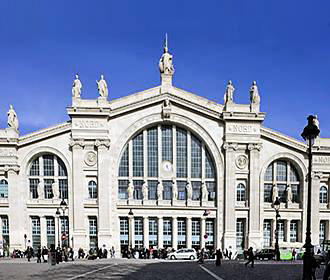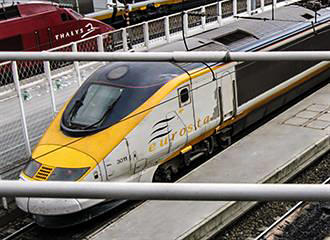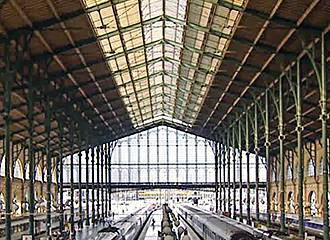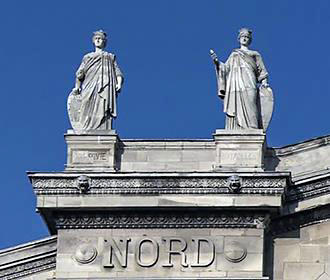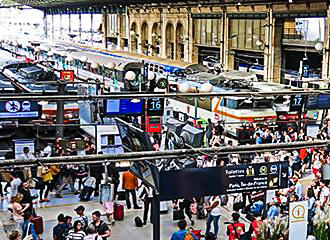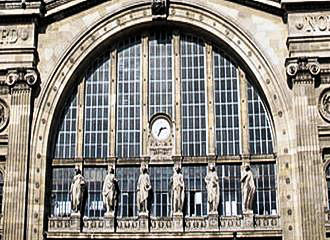Paris Gare du Nord train station
The Paris Gare du Nord train station is one of the main stations in Paris and is actually the busiest train station in Europe that services around 190 million travellers each year with connections to other countries such as Belgium and the Netherlands, plus this is where the Eurostar train arrives and departs for the UK.
Gare du Nord train station history
The first Paris Gare du Nord train station was officially opened in 1846 for the Chemin de Fer du Nord company, however, within only a few years it ended up being too small and by 1860 this train station was partly demolished in order to make way for a larger station and the original facade was transferred to Lille.
It was decide that the French architect Jacques Ignace Hittorff, who designed the Cirque d'Hiver circus, buildings along the Champs-Elysees, facades by the Arc de Triomphe and redesigned the Place de la Concorde, would be the ideal person to re-design the new Paris Gare du Nord train station.
Jacques Ignace Hittorff was chosen by the chairman of the Chemin de Fer du Nord company mainly because of his approach to architecture utilising more modern materials such as cast iron. So construction was started in the May of 1861, and although the train station was opened for service in 1864, the building was not fully completed until the December of 1865.
About the Paris Gare du Nord train station building
Now the Paris Gare du Nord train station building was designed in the usual way for a terminus station of a U shape, with the main supporting beam and the support pillars being made out of cast iron, and in fact, these had to be produced in Glasgow in the UK, as this was the only foundry large enough at the time to produced the supports.
The stone facade was designed in a triumphal arch style and you will notice that on the top of the building at the cornice line there are a total of nine statues that represent different cities where the train company operated. Of course the main centre statue represents Paris, but the other eight are for London, Amsterdam, Berlin, Brussels, Cologne, Frankfurt, Vienna and Warsaw.
There are also an additional fourteen smaller statues on the facade that represent French cities where the Chemin de Fer du Nord company operated such as Lille, Rouen, Boulogne, Dunkerque and Calais, plus there is an additional statue representing Paris.
However, as with the majority of train stations, the Paris Gare du Nord train station soon became too small to deal with the amount of trains and passengers. So in 1884 an additional five tracks were put in place, then ready for the World Fair in 1889, which was when the Eiffel Tower was built, the interior of the station was completely rebuilt and an extension was added.
Over the years there have been additional expansion works carried out on the Paris Garde du Nord train station and the railway lines, with the most notable one being in 1994 when the railways tracks had to be completely reorganised in order to service the Eurostar trains that travel through the Channel Tunnel from the UK.
Yet there are plans to improve things for passengers again, by linking the Paris Gare du Nord with the Gare de l'Est train station in Paris, as they are exceedingly close and commuters often have to transfer between these two stations.
The Paris Gare du Nord train station today
The first two train platforms are only for service, but the first ones open to commuters are platforms 3 to 6 that are the terminus for the Eurostar trains and these are separated from the rest of the trains due to the security checks and passport controls, as although the UK is part of the EU, it does not come under the Schengen Agreement of no border controls.
Then 7 and 8 are for the high speed trains going to Germany, Belgium and the Netherlands, which are all part of the Schengen Agreement.
Platforms 9 to 18 are high speed trains through France and main line trains then 30 to 36 are the more standard trains and for those around the Ile de France region, and 41 to 44 are underground for the RER trains which service the Stade de France and Charles de Gaulle Airport, plus there are 4 different Metro platforms as well.
Located on Level 1 there are luggage lockers that can hold up to two good sized suitcases and these are great if you wish to spend a few more hours in Paris prior to your departure, and the different sized lockers range in cost from around €6 up to €12 and are for a maximum duration of 48 hours.
The Paris Gare du Nord train station public toilets are situated close to railway line number 36, but do bear in mind that there is a charge of €0.50 to access these, yet there are coin machines in the station if you need to change up one of your Euro banknotes.
And located in the 10th Arrondissement of Paris within the Gare du Nord train station there is also a currency exchange along with a WiFi hotspot and you can purchase access tickets at the Relay shop in the departure lounge. Plus of course there are numerous different boutiques for those last minute mementos, holiday gifts or even flowers, in addition to different places to eat or grab a quick snack such as the Bonne Journee overlooking the railway tracks.
And if you have ever seen one of the movies like the Bourne Identity, Ocean's Twelve or Mr Beans Holiday, then you may well recognise that the Paris Gare du Nord train station was actually featured within these films, and is easily accessible from virtually anywhere via different forms of Paris public transport and beyond.
